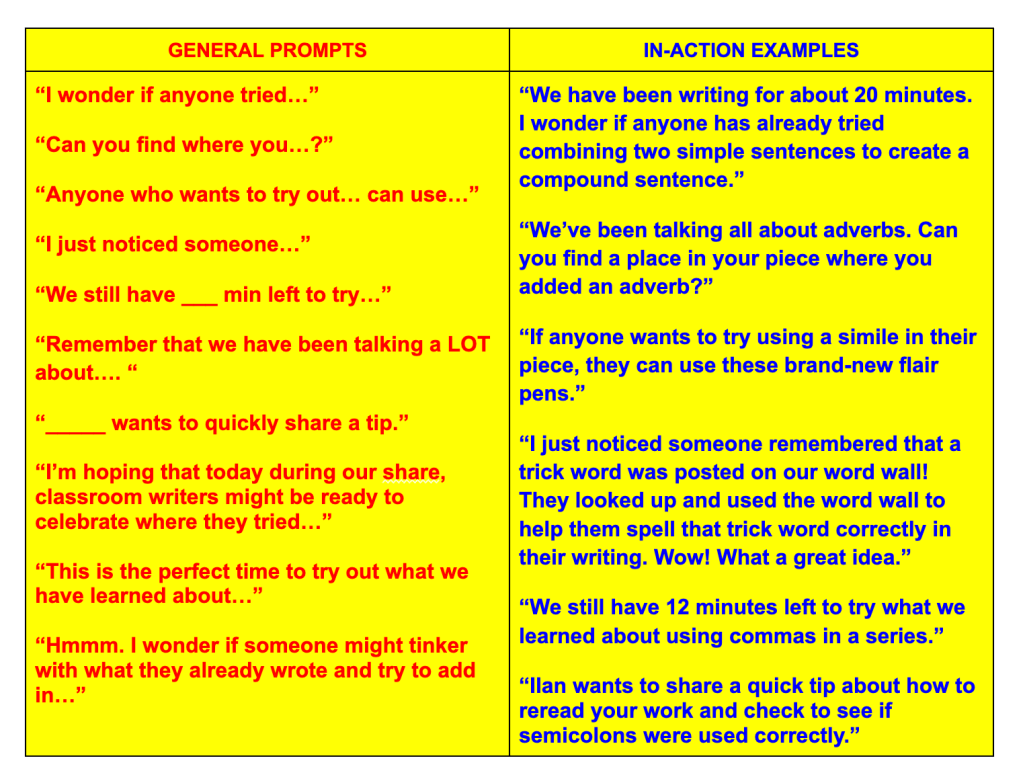The other day, I did it again. I drafted an email to my bosses. Read it. Reread it. Hit send. Got distracted. Then… saw it. The error.
These moments of regret keep me humble! And so, when I notice students not applying taught spelling and grammar concepts, I remind myself that they are not defiantly plotting to annoy me. Instead, I use these observations as a reminder. Teachers of writing need to consistently model and teach into transfer. With this in mind, here are a few ready-to-go ideas for embedding editing practice all along the way.
Customize Checklists: We can only hold students accountable for what’s been introduced, explicitly taught, and practiced. Instead of listing a menu of vague grammar concepts on a stagnant checklist, consider creating unit-specific checklists. Over the course of the year (and as students’ repertoire of taught conventions grows), the unit checklists expand in length and breadth. Feature these checklists in minilessons, partner time, mid-workshop interruptions, and shares. The below examples show a series of second-grade checklists.
Click here to access a PDF of these checklists.
Weave it in Weekly: Instead of waiting until the last week of a unit to mention editing, try weaving it in weekly. In some classrooms, this means dedicating one (consistent) day each week to the application of spelling and grammar knowledge. If, for example, you chose Fridays, then each Friday’s lesson would be focused on a strategy for remembering and using spelling and/or grammar knowledge while writing. During that session, the teacher would spend time conferring with students or meeting with small groups with this goal. Partner time and/or the teaching share at the end of the workshop session could also align with this theme. There are double benefits to earmarking one day a week for this work. First, it prioritizes practice across time and across pieces. Second, it ensures the majority of writing time is devoted to other writing pursuits. In this way, spelling and grammar are A consistent focus, but not THE consistent focus.
Make the Most of the MWI: Ahhh, the forgotten mid-workshop interruption. One of the best ways to remember this brief, yet powerful teaching opportunity is to build a routine. For many years, I devoted every Tuesday’s mid-workshop interruption to phonics, spelling, or vocabulary and every Thursday’s mid-workshop interruption to grammar. The chart below shows what you might have heard if you eavesdropped on some of these mid-workshop interruptions. These tiny, yet mighty moves yield big results!
Play Up Partner Time: Having another set of eye’s on your work is powerful! Bring intention to this work by creating explicit routines that support thoughtful partner collaboration. Over the course of the year, slowly teach different conventions-themed partner games. One of my favorites is “Checklist I Spy.” The teacher (or partnership) chooses ONE part of the checklist. Partners play “I Spy” in each other’s pieces, going on a scavenger hunt for that specific convention. When the partner spies a correctly-used convention, they congratulate the writer. When the partner spies an incorrectly spelled word or grammar mistake, they offer “hints” to support the writer as the writer fixes it up. The roles then reverse and this process is then repeated in the other partner’s piece. Those who feel they are early finishers have two options: keep checking for that target convention in additional booklets/notebook entries OR choose a new aspect of the checklist and repeat the process by playing “I Spy” for that convention.
Collaborate & Celebrate: If we wait until the end of the unit to celebrate, there may not be much to highlight! Consider concluding a writing session with a conventions-themed share, ideally once or twice a week. Once again, the unit editing checklist can have a starring role. Choose one convention listed on the checklist and have students find and celebrate at least one place they tried transferring recent language learning. Cheer classroom writers on as they honor and share their ongoing efforts.
BONUS TIP: Use fun tools! I am not opposed to a gimmick – IF it is free/cheap, readily available, and is grounded in purposeful work. Invite students to use brand-new flair pens. Make scented markers available. Pass out the sparkle gel pens. Offer different colored, sized, and shaped sticky notes. Capitalize on the seemingly universal appeal of highlighting tape. Go ahead and encourage young writers to those mini magnifying glasses or silly pointers. Bring a spirit of tinkering to editing so that it feels more like “making.” Model and inspire plenty of playfulness within the process of editing. The visual and tactile appeal of different tools just might encourage initially reticent editors to give this a go!
When it comes to editing, efficient embedding is the way to go. Spending a few (yet consistent) minutes makes quite an impact! Try sprinkling a few of these ideas into your current unit. Then, celebrate the more consistent transfer and application that’s sure to result.







Such practical tips. And timely! We need this right now! Thank you.
LikeLike